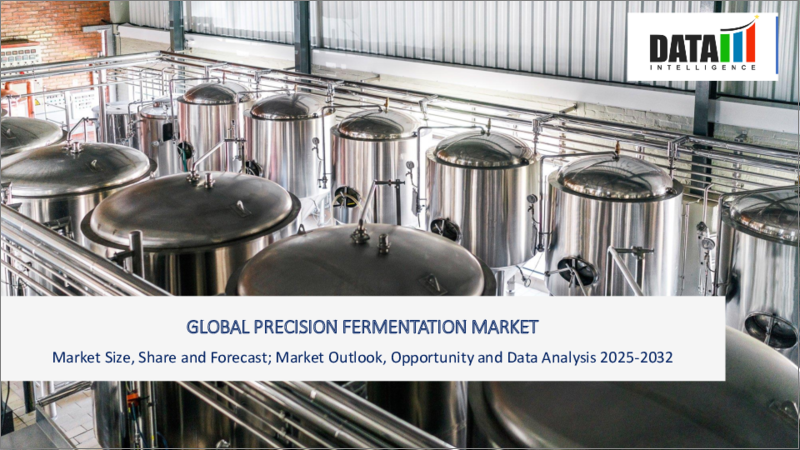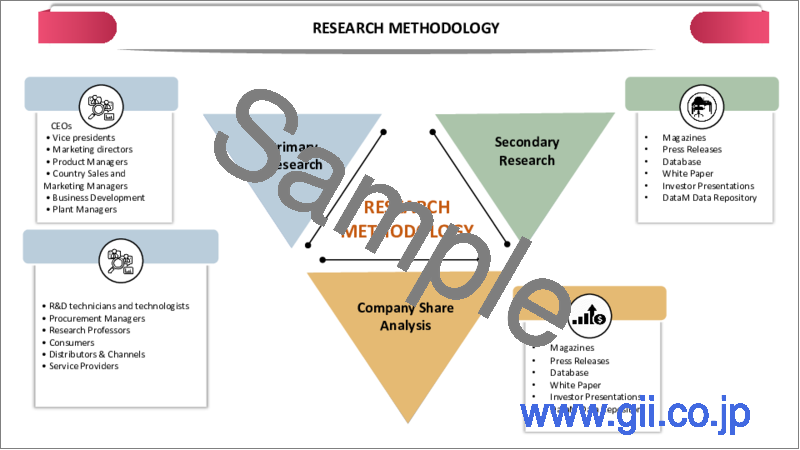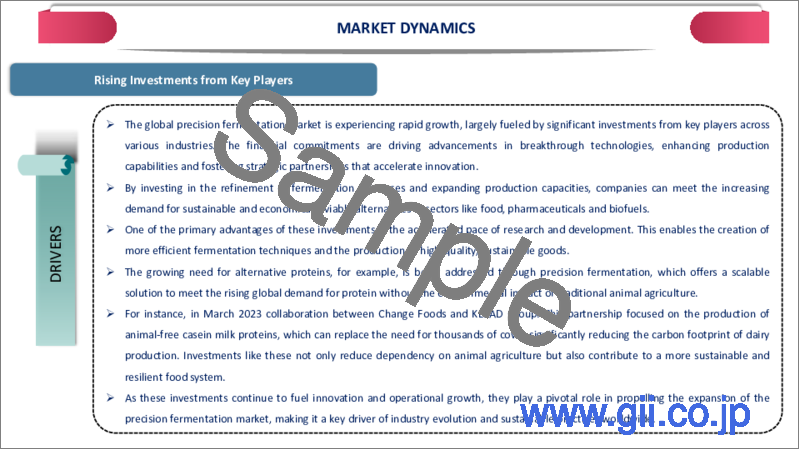|
|
市場調査レポート
商品コード
1588586
精密発酵の世界市場:2024年~2031年Global Precision Fermentation Market - 2024-2031 |
||||||
カスタマイズ可能
適宜更新あり
|
|||||||
| 精密発酵の世界市場:2024年~2031年 |
|
出版日: 2024年11月08日
発行: DataM Intelligence
ページ情報: 英文 202 Pages
納期: 即日から翌営業日
|
- 全表示
- 概要
- 目次
概要
世界の精密発酵市場は、2023年に31億6,000万米ドルに達し、2031年には481億6,000万米ドルに達すると予測され、予測期間2024-2031年のCAGRは40.56%で成長する見込みです。
精密発酵は、タンパク質、酵素、その他の化合物を効率的に生産するために、従来の発酵と最先端のバイオテクノロジーの進歩を統合する方法です。食品と飲料におけるタンパク質開発へのこの合成的アプローチは、土地と水資源への依存を減らすと同時に炭素排出を削減します。この技術は、消費者の間で高まる代替タンパク質への世界の需要に対応するのに非常に適しています。
市場成長の主な促進要因は、菜食主義に対する消費者の態度の変化、タンパク質消費の増加、技術への投資の急増です。遺伝子工学の大幅な進歩により、精密発酵による経済的かつ持続可能な微生物の再プログラミング(合成生物学)が容易になり、多様な特定食物タンパク質成分の生産が可能になった。
成長企業は市場参入企業に利益をもたらすチャンスを提供しています。2023年5月、Geltor社は、卓越した肌の若返り効果をもたらすビーガン・イル・コラーゲン・ポリペプチド、CAVIANCE(TM)を発売しました。この新しい物質は、6種類のコラーゲンを活性化し、強い抗酸化力を発揮し、創傷治癒を促進します。
従来の動物由来の食肉から、環境的に持続可能で安全な代替食肉に移行する人が増えています。欧州は、従来の動物性食品に匹敵する食感や風味を維持しつつ、汚染を低減する動物性タンパク質の同定・生産への投資が増加している著名な市場です。ドイツ、英国、フランスは、精密発酵を利用したタンパク質の主要生産国です。
ダイナミクス
ヴィーガンと肉を食べないライフスタイルの拡大
The Hartman Groupの調査によると、北米の精密発酵食品市場は大きな変革の瀬戸際にあります。米国の成人の約40%、9,000万人以上が精密発酵製品を採用する用意があり、2027年までに1億3,200万人の消費者に成長すると予測されています。若い世代は、環境に対する不安や持続可能性に従順であり、2番目に重要な点は環境への有益な影響です。これは、彼らが持続可能な消費に傾倒していることと対応しています。
温室効果ガスの排出削減や有機農業、環境に優しいパッケージングなど、精密発酵と持続可能性の結びつきは、技術革新の機会を提示しています。ミレニアル世代とZ世代は、こうしたことに10%の追加料金を支払う用意があります。この技術は、顧客の選択と環境意識の変化に影響された、より持続可能で技術的に進んだ市場情勢の触媒として機能します。この動向は、精密発酵食品市場の拡大を一貫して後押ししています。
主要企業による投資の増加
主要企業による多額の投資は、画期的な技術に資金を供給し、生産能力を強化し、戦略的提携を育成することによって、精密発酵市場の拡大を推進しています。こうした投資により、企業は事業を拡大し、発酵プロセスの効率を向上させ、食品、医薬品、バイオ燃料などの分野で革新的な用途を創出することができます。こうした資金援助により研究開発が促進され、持続可能で経済的に実行可能な発酵に基づく商品の生産が実現し、市場の成長が促進されます。
数多くの組織が、この技術を利用した代替タンパク質の生産強化に努めています。持続可能な食品開発の必要性の高まりは、大規模なタンパク質生産に対する需要の高まりと並行しています。2023年3月、ミルクカゼイン生産に注力するChange Foods社は、UAEを拠点とするKEZAD Groupと協力し、1万頭の牛の代替となる動物性カゼイン乳タンパク質を生産しました。この投資は畜産への依存を減らし、持続可能な食品生産と調達を促進します。
製造コストの上昇
微生物をベースとする精密発酵タンパク質と油脂の需要は最近急増しています。さらに、精密発酵は土地や水の使用を減らし、温室効果ガスの排出を抑え、動物由来の製品に関連する健康上の問題を軽減するなど、多くの利点を提供します。
とはいえ、生産価格の高騰が、事業拡大の主な制約となっています。微生物用の特殊な培地、大規模な発酵槽、特殊な精製方法を使用するため、製造コストは非常に高くなります。バクテリアの増殖には安定した無菌環境が必要なため、収量不良や汚染の危険性も高まる。
目次
第1章 調査手法と調査範囲
第2章 定義と概要
第3章 エグゼクティブサマリー
第4章 市場力学
- 影響要因
- 促進要因
- ビーガンおよび肉を食べないライフスタイルの拡大
- 大手企業による投資の増加
- 抑制要因
- 製造コストの上昇
- 機会
- 影響分析
- 促進要因
第5章 産業分析
- ポーターのファイブフォース分析
- サプライチェーン分析
- 価格分析
- 規制分析
- ロシア・ウクライナ戦争影響分析
- DMIの見解
第6章 COVID-19分析
第7章 微生物別
- 細菌
- 酵母
- 藻類
- 菌類
第8章 成分別
- 卵タンパク質
- ヘムタンパク質
- コラーゲンタンパク質
- ホエイとカゼインタンパク質
- 酵素
- その他
第9章 用途別
- 肉・魚介類
- 乳製品代替品
- 卵代替食品
- 加工食品・飲食品
- スキンケア・ヘアケア製品
- その他
第10章 エンドユーザー別
- 飲食品
- 化粧品
- 医薬品
- その他
第11章 地域別
- 北米
- 米国
- カナダ
- メキシコ
- 欧州
- ドイツ
- 英国
- フランス
- イタリア
- スペイン
- その他欧州
- 南米
- ブラジル
- アルゼンチン
- その他南米
- アジア太平洋
- 中国
- インド
- 日本
- オーストラリア
- その他アジア太平洋地域
- 中東・アフリカ
第12章 競合情勢
- 競合シナリオ
- 市況/シェア分析
- M&A分析
第13章 企業プロファイル
- Geltor
- 会社概要
- 製品ポートフォリオと説明
- 財務概要
- 主な発展
- Perfect Day, Inc.
- The Every Co.
- Impossible Foods Inc.
- Motif FoodWorks, Inc.
- Imagindairy Ltd.
- Shiru, Inc.
- Formo
- Eden Brew
- Change Foods
第14章 付録
Overview
Global Precision Fermentation Market reached US$ 3.16 billion in 2023 and is expected to reach US$ 48.16 billion by 2031, growing with a CAGR of 40.56% during the forecast period 2024-2031.
Precision fermentation is a method that integrates conventional fermentation with cutting-edge biotechnological advancements to efficiently produce proteins, enzymes and other compounds. This synthetic approach to protein development in food and drinks diminishes dependence on land and water resources while reducing carbon emissions. The technology is very well-suited to address the growing global demand for alternative proteins among consumers.
The primary drivers of market growth are shifting consumer attitudes towards veganism, heightened protein consumption and escalating investments in technologies. Significant advancements in genetic engineering have facilitated the economical and sustainable reprogramming of microbes (synthetic biology) via precision fermentation to produce a diverse array of specific dietary protein components.
The growing firm has provided profitable chances to market participants. In May 2023, Geltor launched CAVIANCE(TM), a vegan Il collagen polypeptide that provides exceptional skin rejuvenation benefits. This new substance activates six distinct collagen types, demonstrates strong antioxidant capabilities and facilitates wound healing.
A growing number of people are transitioning from conventional animal-derived meat to environmentally sustainable and safe meat alternatives. Europe is a prominent market increasingly investing in the identification and production of animal proteins that generate reduced pollution while maintaining comparable texture and flavor to traditional animal products. Germany, UK and France are the foremost producers of proteins using precision fermentation.
Dynamics
Growing Vegan and Meat-free Lifestyle
Research from The Hartman Group indicates that the North American precision fermentation ingredient market is on the brink of a significant transformation. Approximately 40% of US adults, exceeding 90 million individuals, are prepared to adopt precision fermentation goods, anticipated to grow to 132 million consumers by 2027. Younger generations are amenable due to environmental apprehensions and sustainability, with the second most significant aspect being the beneficial effect on the environment. This corresponds with their inclination towards sustainable consumption.
The connection between precision fermentation and sustainability, encompassing diminished greenhouse gas emissions organic agriculture and eco-friendly packaging, presents opportunities for innovation. Millennials and Gen Z are prepared to pay an additional 10% for these things. This technology acts as a catalyst for a more sustainable and technologically advanced market landscape influenced by changing customer choices and environmental awareness. This trend consistently bolsters the expansion of the precision fermentation ingredient market.
Rising Investments by Major Players
Significant investments from key players are propelling the expansion of the precision fermentation market by financing breakthrough technologies, enhancing production capacities and cultivating strategic alliances. These investments allow enterprises to expand operations, improve fermentation process efficiency and create innovative uses in sectors including as food, pharmaceuticals and biofuels. This financial assistance expedites research and development, resulting in the production of sustainable and economically viable fermentation-based goods, hence enhancing market growth.
Numerous organizations are endeavoring to enhance the creation of alternative proteins utilizing this technique. The increasing necessity for sustainable food development is paralleled by a rising demand for large-scale protein production. In March 2023, Change Foods, a firm focused on milk casein production, collaborated with UAE-based KEZAD Group to produce animal-free casein milk proteins capable of substituting 10,000 cows. This investment diminishes dependence on animal agriculture and promotes sustainable food production and sourcing.
Higher Manufacturing Costs
The demand for microbe-based precision fermented proteins and fats has surged recently, driven by the growing preference for animal-free goods among the expanding vegan population. Moreover, precise fermentation offers numerous advantages: it diminishes land and water use, lowers greenhouse gas emissions and mitigates health issues linked to animal-derived goods.
Nevertheless, elevated production prices have served as the primary constraint for the business to expand. The use of specific growing media for microorganisms, large-scale fermenters and specialized purification methods collectively escalates manufacturing costs enormously. The danger of yield failure or contamination is elevated, as bacteria require a steady and sterile environment for proliferation.
Segment Analysis
The global precision fermentation market is segmented based on microbe, ingredient, application, end-user and region.
The Manufacturing Of Whey And Casein Protein With Innovative Technologies
Numerous firms are investing in the development of sophisticated and functional proteins produced by precision fermentation processes. Furthermore, these proteins are deemed safe and classified within the generally recognized as safe (GRAS) category in Europe. Consequently, most companies in the food and beverage sector are investing in the development of whey and casein proteins that align with changing customer demands.
The increasing popularity of animal-free protein bolsters the demand for alternative proteins produced through modern technologies. Companies like Mycorena and MycoTechnology, Inc. are employing this technique to produce proteins for the creation of meat analogues. Consequently, this sector represents the second biggest market share in the global industry. Additional products, including enzymes utilized in the production of fermented drinks and wines, as well as egg protein for egg manufacturing, are progressively being produced using this process.
Geographical Penetration
Healthy Food Trends and Sustainability Preferences in North America
North America continued to be the predominant market for precision fermentation ingredient, driven by heightened consumer awareness, the consumption of healthful food components and the move towards veganism. The North American precision fermentation ingredient industry is on the verge of a significant transformation; around 40% of US adults, over 90 million individuals, are prepared to adopt precision fermentation goods, anticipated to expand to 132 million customers by 2027 (The Hartman Group).
Younger generations are amenable due to environmental apprehensions and sustainability, with the second most significant aspect being the beneficial effect on the environment. The correlation between precision fermentation ingredient and sustainability, encompassing diminished greenhouse gas emissions organic agriculture and eco-friendly packaging, presents opportunities for innovation. Millennials and Gen Z are prepared to spend up to 10% more for these things. It acts as a catalyst for a more sustainable and technologically advanced market landscape influenced by changing customer choices and environmental awareness.
Competitive Landscape
The major global players in the market include Geltor, Perfect Day, Inc., The Every Co., Impossible Foods Inc., Motif FoodWorks, Inc., Imagindairy Ltd., Shiru, Inc., Formo, Eden Brew and Change Foods.
Russia-Ukraine War Impact Analysis
Russia and Ukraine are major exporters of wheat, corn and other agricultural products essential for the production of specific fermentation components. The conflict has interrupted the delivery of essential raw materials, leading to increased costs and shortages. The conflict has led to significant surges in energy costs, exerting pressure on the profitability of precision fermentation businesses.
Since the onset of the conflict, precision fermentation companies have experienced an average rise of 30% in energy expenses. Costly food imports can be replaced by local precision fermentation (PF) production facilities, allowing humans to engineer microbes to generate proteins with specific flavor, texture and nutritional attributes. These hubs can be powered by clean electricity through SWB, which, if executed effectively by overdeveloping solar and wind resources, can yield substantial excess energy at minimal marginal costs for the majority of the year.
Microbe
- Bacteria
- Yeast
- Algae
- Fungi
Ingredient
- Egg protein
- Heme protein
- Collagen protein
- Whey and Casein protein
- Enzymes
- Others
Application
- Meat and Seafood
- Dairy Alternatives
- Egg Alternatives
- Processed food and beverages
- Skincare and haircare products
- Others
End-User
- Food and Beverages
- Cosmetics
- Pharmaceuticals
- Others
By Region
- North America
- US
- Canada
- Mexico
- Europe
- Germany
- UK
- France
- Italy
- Spain
- Rest of Europe
- South America
- Brazil
- Argentina
- Rest of South America
- Asia-Pacific
- China
- India
- Japan
- Australia
- Rest of Asia-Pacific
- Middle East and Africa
Key Developments
- In February 2024, Nestle SA introduced their inaugural dairy protein powder derived via precision fermentation, characterized as both animal-free and lactose-free whey isolate. The introduction of this new product enabled the company to reinforce its standing in the functional nutrition sector.
- In February 2024, Vivici, a business established through the collaboration of Fonterra and DSM-Firmenich, revealed its intention to manufacture industrial-scale whey protein by precision fermentation. This will assist the company in satisfying the increasing demand for 'animal-free protein' in the US market.
- In February 2024, Perfect Day, a US-based maker of precision fermentation products, collaborated with Unilever's Breyers to announce the forthcoming debut of Breyers Lactose-Free Chocolate. This product will consist of dairy protein, obtained by this technology.
- In May 2023, The EVERY Company and Alpha Foods formally established a Joint Development Agreement with the common goal of introducing next-generation alternative meat products to the market. This partnership seeks to utilize EVERY's pioneering proficiency in animal-free protein manufacturing alongside Alpha Foods' esteemed chef-crafted plant-based offerings to enhance the flavor and texture of non-animal goods.
- In March 2023, the collaboration of The Hartman Group, Perfect Day and Cargill provided Perfect Day with significant information into customer views and preferences about precision fermentation components. This data has enabled Perfect Day to fortify its market position and lead the Precision Fermentation Alliance.
Why Purchase the Report?
- To visualize the global precision fermentation market segmentation based on microbe, ingredient, application, end-user and region, as well as understand key commercial assets and players.
- Identify commercial opportunities by analyzing trends and co-development.
- Excel data sheet with numerous data points of the precision fermentation market-level with all segments.
- PDF report consists of a comprehensive analysis after exhaustive qualitative interviews and an in-depth study.
- Product mapping available as excel consisting of key products of all the major players.
The global precision fermentation market report would provide approximately 70 tables, 70 figures and 202 pages
Target Audience 2024
- Manufacturers/ Buyers
- Industry Investors/Investment Bankers
- Research Professionals
- Emerging Companies
Table of Contents
1. Methodology and Scope
- 1.1. Research Methodology
- 1.2. Research Objective and Scope of the Report
2. Definition and Overview
3. Executive Summary
- 3.1. Snippet by Microbe
- 3.2. Snippet by Ingredient
- 3.3. Snippet by Application
- 3.4. Snippet by End-User
- 3.5. Snippet by Region
4. Dynamics
- 4.1. Impacting Factors
- 4.1.1. Drivers
- 4.1.1.1. Growing Vegan and Meat-free Lifestyle
- 4.1.1.2. Rising Investments by Major Players
- 4.1.2. Restraints
- 4.1.2.1. Higher Manufacturing Costs
- 4.1.3. Opportunity
- 4.1.4. Impact Analysis
- 4.1.1. Drivers
5. Industry Analysis
- 5.1. Porter's Five Force Analysis
- 5.2. Supply Chain Analysis
- 5.3. Pricing Analysis
- 5.4. Regulatory Analysis
- 5.5. Russia-Ukraine War Impact Analysis
- 5.6. DMI Opinion
6. COVID-19 Analysis
- 6.1. Analysis of COVID-19
- 6.1.1. Scenario Before COVID-19
- 6.1.2. Scenario During COVID-19
- 6.1.3. Scenario Post COVID-19
- 6.2. Pricing Dynamics Amid COVID-19
- 6.3. Demand-Supply Spectrum
- 6.4. Government Initiatives Related to the Market During Pandemic
- 6.5. Manufacturers Strategic Initiatives
- 6.6. Conclusion
7. By Microbe
- 7.1. Introduction
- 7.1.1. Market Size Analysis and Y-o-Y Growth Analysis (%), By Microbe
- 7.1.2. Market Attractiveness Index, By Microbe
- 7.2. Bacteria*
- 7.2.1. Introduction
- 7.2.2. Market Size Analysis and Y-o-Y Growth Analysis (%)
- 7.3. Yeast
- 7.4. Algae
- 7.5. Fungi
8. By Ingredient
- 8.1. Introduction
- 8.1.1. Market Size Analysis and Y-o-Y Growth Analysis (%), By Ingredient
- 8.1.2. Market Attractiveness Index, By Ingredient
- 8.2. Egg protein*
- 8.2.1. Introduction
- 8.2.2. Market Size Analysis and Y-o-Y Growth Analysis (%)
- 8.3. Heme protein
- 8.4. Collagen protein
- 8.5. Whey and Casein protein
- 8.6. Enzymes
- 8.7. Others
9. By Application
- 9.1. Introduction
- 9.1.1. Market Size Analysis and Y-o-Y Growth Analysis (%), By Application
- 9.1.2. Market Attractiveness Index, By Application
- 9.2. Meat and Seafood*
- 9.2.1. Introduction
- 9.2.2. Market Size Analysis and Y-o-Y Growth Analysis (%)
- 9.3. Dairy Alternatives
- 9.4. Egg Alternatives
- 9.5. Processed food and beverages
- 9.6. Skincare and haircare products
- 9.7. Others
10. By End-User
- 10.1. Introduction
- 10.1.1. Market Size Analysis and Y-o-Y Growth Analysis (%), By End-User
- 10.1.2. Market Attractiveness Index, By End-User
- 10.2. Food and Beverages*
- 10.2.1. Introduction
- 10.2.2. Market Size Analysis and Y-o-Y Growth Analysis (%)
- 10.3. Cosmetics
- 10.4. Pharmaceuticals
- 10.5. Others
11. By Region
- 11.1. Introduction
- 11.1.1. Market Size Analysis and Y-o-Y Growth Analysis (%), By Region
- 11.1.2. Market Attractiveness Index, By Region
- 11.2. North America
- 11.2.1. Introduction
- 11.2.2. Key Region-Specific Dynamics
- 11.2.3. Market Size Analysis and Y-o-Y Growth Analysis (%), By Microbe
- 11.2.4. Market Size Analysis and Y-o-Y Growth Analysis (%), By Ingredient
- 11.2.5. Market Size Analysis and Y-o-Y Growth Analysis (%), By Application
- 11.2.6. Market Size Analysis and Y-o-Y Growth Analysis (%), By End-User
- 11.2.7. Market Size Analysis and Y-o-Y Growth Analysis (%), By Country
- 11.2.7.1. US
- 11.2.7.2. Canada
- 11.2.7.3. Mexico
- 11.3. Europe
- 11.3.1. Introduction
- 11.3.2. Key Region-Specific Dynamics
- 11.3.3. Market Size Analysis and Y-o-Y Growth Analysis (%), By Microbe
- 11.3.4. Market Size Analysis and Y-o-Y Growth Analysis (%), By Ingredient
- 11.3.5. Market Size Analysis and Y-o-Y Growth Analysis (%), By Application
- 11.3.6. Market Size Analysis and Y-o-Y Growth Analysis (%), By End-User
- 11.3.7. Market Size Analysis and Y-o-Y Growth Analysis (%), By Country
- 11.3.7.1. Germany
- 11.3.7.2. UK
- 11.3.7.3. France
- 11.3.7.4. Italy
- 11.3.7.5. Spain
- 11.3.7.6. Rest of Europe
- 11.4. South America
- 11.4.1. Introduction
- 11.4.2. Key Region-Specific Dynamics
- 11.4.3. Market Size Analysis and Y-o-Y Growth Analysis (%), By Microbe
- 11.4.4. Market Size Analysis and Y-o-Y Growth Analysis (%), By Ingredient
- 11.4.5. Market Size Analysis and Y-o-Y Growth Analysis (%), By Application
- 11.4.6. Market Size Analysis and Y-o-Y Growth Analysis (%), By End-User
- 11.4.7. Market Size Analysis and Y-o-Y Growth Analysis (%), By Country
- 11.4.7.1. Brazil
- 11.4.7.2. Argentina
- 11.4.7.3. Rest of South America
- 11.5. Asia-Pacific
- 11.5.1. Introduction
- 11.5.2. Key Region-Specific Dynamics
- 11.5.3. Market Size Analysis and Y-o-Y Growth Analysis (%), By Microbe
- 11.5.4. Market Size Analysis and Y-o-Y Growth Analysis (%), By Ingredient
- 11.5.5. Market Size Analysis and Y-o-Y Growth Analysis (%), By Application
- 11.5.6. Market Size Analysis and Y-o-Y Growth Analysis (%), By End-User
- 11.5.7. Market Size Analysis and Y-o-Y Growth Analysis (%), By Country
- 11.5.7.1. China
- 11.5.7.2. India
- 11.5.7.3. Japan
- 11.5.7.4. Australia
- 11.5.7.5. Rest of Asia-Pacific
- 11.6. Middle East and Africa
- 11.6.1. Introduction
- 11.6.2. Key Region-Specific Dynamics
- 11.6.3. Market Size Analysis and Y-o-Y Growth Analysis (%), By Microbe
- 11.6.4. Market Size Analysis and Y-o-Y Growth Analysis (%), By Ingredient
- 11.6.5. Market Size Analysis and Y-o-Y Growth Analysis (%), By Application
- 11.6.6. Market Size Analysis and Y-o-Y Growth Analysis (%), By End-User
12. Competitive Landscape
- 12.1. Competitive Scenario
- 12.2. Market Positioning/Share Analysis
- 12.3. Mergers and Acquisitions Analysis
13. Company Profiles
- 13.1. Geltor*
- 13.1.1. Company Overview
- 13.1.2. Product Portfolio and Description
- 13.1.3. Financial Overview
- 13.1.4. Key Developments
- 13.2. Perfect Day, Inc.
- 13.3. The Every Co.
- 13.4. Impossible Foods Inc.
- 13.5. Motif FoodWorks, Inc.
- 13.6. Imagindairy Ltd.
- 13.7. Shiru, Inc.
- 13.8. Formo
- 13.9. Eden Brew
- 13.10. Change Foods
LIST NOT EXHAUSTIVE
14. Appendix
- 14.1. About Us and Services
- 14.2. Contact Us





